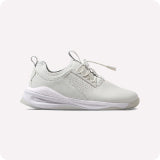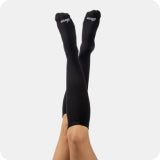Why Do The Soles of My Feet Hurt?
In a fast-paced world where we're always on the move, the question "Why do the soles of my feet hurt?" goes beyond curiosity. It reflects the pressures our feet endure daily. At Clove, we're more than just about comfort. We're dedicated to creating a sanctuary for your tired feet, supporting you every step of the way.
What is Foot Pain?
Foot pain is a general term for any discomfort or ache you experience in your feet, from your toes up to your heels. It's a common issue because our feet are complex structures that take on a lot of stress throughout the day.
There are two main categories for what causes foot pain: overuse and structural problems.
Overuse can happen from activities like standing or walking for long periods, especially if you're not wearing supportive shoes.
Structural problems refer to issues with the actual bones, muscles, or tendons in your foot. This could be anything from a broken bone to a bunion to plantar fasciitis.
Common Causes of Sole Pain
#1 Plantar Fasciitis
Characterized by the inflammation of the plantar fascia, this condition serves as a stark reminder of the strains we subject our feet to. It's essential to recognize the early signs, such as sharp pain in the heel bone upon waking, as early intervention can significantly ease the recovery process. Incorporating foot-specific exercises and seeking professional advice can provide pain relief and eventually mitigate the long-term impacts of this ailment.
#2 Overuse or Strain
The relentless demand we put on our feet can sometimes exceed their capacity, leading to overuse injuries manifesting as soreness or acute pain in the soles. Recognizing the balance between activity and rest is crucial, as is adopting pain management practices that distribute pressure evenly across the foot, thereby reducing the risk of strain-induced discomfort.
#3 Improper Footwear
The choice of footwear is not merely about aesthetic appeal but is a critical factor in maintaining foot health. Shoes that lack adequate support or fail to match the foot's contour can cause or exacerbate work injuries or even lead to the development of some chronic foot pain. It's important to select footwear based on activity type, foot shape, and support needs, thereby ensuring that each step is cushioned against undue stress.
#4 Foot Structure Issues
Variations in foot structure, such as flat feet or high arches, necessitate a tailored approach to foot care. Understanding your foot type is essential in selecting the right footwear and support mechanisms, such as custom orthotics, which can play a pivotal role in alleviating pressure points and distributing weight more evenly across the sole.
Since our feet are the base that keeps us mobile, it's important to take care of them. A holistic approach to foot health means considering both prevention and proactive care.
Prevention focuses on avoiding arch pain, heel pain, and overall foot problems before they start. This includes wearing shoes that fit well and provide good arch support. It's also wise to avoid high heels too often, as they can put extra strain on your feet.
Proactive care involves things you can do to strengthen your feet and make them more resilient. Stretching exercises and foot-specific workouts can help improve flexibility and muscle strength, making your feet less susceptible to injury.
How to Help Sore Soles
Rest and Ice
Embracing rest and the application of ice can significantly reduce inflammation, offering a reprieve to stressed soles. This simple yet effective approach on how to treat sore feet serves as a foundation for more targeted interventions, underscoring the importance of listening to our bodies and responding with care and consideration.
Stretching Exercises
Integrating stretching exercises into your daily routine can enhance flexibility, improve blood flow, and alleviate tension in the soles. Exercises targeting the Achilles tendon and plantar fascia can be particularly beneficial, serving as a proactive measure against the onset of pain.
Footwear Recommendations
At Clove, our dedication to hard-working professionals has driven us to design footwear that embodies both form and function. Our shoes are not just an accessory but a testament to our commitment to your well-being, offering unparalleled support and comfort tailored to the unique demands of your profession.
Foot Pain Prevention Tips
Proper Footwear
The cornerstone of preventing sole pain lies in the judicious selection of footwear. Shoes that provide a harmonious balance of support, cushioning, and flexibility can significantly mitigate the risk of foot-related discomfort, exemplifying our ethos of care and precision in every product we offer.
Foot Care Habits
Establishing a comprehensive foot care regimen is paramount in maintaining the health and resilience of your feet. Regular inspections for signs of stress (such as calluses and an often strained-feeling calf muscle), combined with practices like moisturizing and careful nail trimming, can prevent common foot problems, reinforcing the importance of proactive and preventive care in ensuring the longevity of your foot health.
As we navigate the complexities of modern life and the demands it places on our feet, let us remember that every step taken is a testament to our resilience and dedication. At Clove, we stand with you, committed to providing a comfortable shoe selection for both men and women that not only addresses the question of "Why are my feet sore?" but also embodies the spirit of care, support, and empowerment that defines us. Let's embark on this journey together, towards a future where foot pain is no longer a barrier but a challenge met with knowledge, compassion, and innovative solutions.
Sources:
- WebMD. Foot Pain. https://www.webmd.com/pain-management/foot-pain-causes-and-treatments
- John Hopkins Medicine. Foot Pain and Problems.https://www.hopkinsmedicine.org/health/conditions-and-diseases/foot-pain-and-problems
- NIH. Foot pressure distribution during walking in young and old adults.https://www.ncbi.nlm.nih.gov/pmc/articles/PMC1173105/



